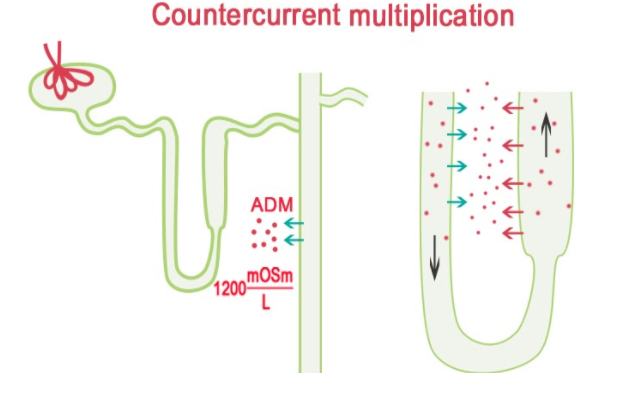
What is the countercurrent mechanism? Describe the physiological basis of the countercurrent mechanism in the kidney.
Answer
482.4k+ views
Hint: The process of transportation of various substances and particles in different directions to maintain a concentration gradient in the kidney resulting in the formation of the urine depending upon the concentration.
Complete answer:
The countercurrent mechanism is the process of creating a concentration gradient and forming concentrated urine. In this process, the energy is required to create a concentration gradient and move the substances in opposite directions. It is a characteristic feature of the mammalian kidneys. The process is involved in the formation of hypertonic urine. This mechanism is also found in the case of birds.
The urine is concentrated in the nephrons, which is the basic structural and functional unit of the kidney. The process occurs in the loop of Henle of the renal tubules present in the kidney. There are two renal tubules that run opposite to each other to create a countercurrent mechanism and in between both the tubules a renal medulla which is an interstitial space is present.
The two tubules of the renal medulla are the descending and the ascending loops. The descending loop of Henle consists of aquaporins which allow the transport of water but do not allow solutes to enter the tubular wall. This water then is transported to the medullary space and makes the urine hypertonic. The hypertonic urine is then transmitted to the ascending loop of Henle where the walls are permeable to ions but impermeable to water making the urine hypotonic. This process is known as the countercurrent mechanism of the kidney.

Note: The countercurrent mechanism is based on the postulates of Werner Kuhn. The mechanism was studied by Gottschalk and Mylle in 1950. This mechanism occurs in the juxtamedullary nephrons. The juxtamedullary nephrons have embedded proximal convoluted tubules inside the loop of Henle and its renal corpuscle is present near the medulla.
Complete answer:
The countercurrent mechanism is the process of creating a concentration gradient and forming concentrated urine. In this process, the energy is required to create a concentration gradient and move the substances in opposite directions. It is a characteristic feature of the mammalian kidneys. The process is involved in the formation of hypertonic urine. This mechanism is also found in the case of birds.
The urine is concentrated in the nephrons, which is the basic structural and functional unit of the kidney. The process occurs in the loop of Henle of the renal tubules present in the kidney. There are two renal tubules that run opposite to each other to create a countercurrent mechanism and in between both the tubules a renal medulla which is an interstitial space is present.
The two tubules of the renal medulla are the descending and the ascending loops. The descending loop of Henle consists of aquaporins which allow the transport of water but do not allow solutes to enter the tubular wall. This water then is transported to the medullary space and makes the urine hypertonic. The hypertonic urine is then transmitted to the ascending loop of Henle where the walls are permeable to ions but impermeable to water making the urine hypotonic. This process is known as the countercurrent mechanism of the kidney.

Note: The countercurrent mechanism is based on the postulates of Werner Kuhn. The mechanism was studied by Gottschalk and Mylle in 1950. This mechanism occurs in the juxtamedullary nephrons. The juxtamedullary nephrons have embedded proximal convoluted tubules inside the loop of Henle and its renal corpuscle is present near the medulla.
Recently Updated Pages
Master Class 11 Accountancy: Engaging Questions & Answers for Success

Glucose when reduced with HI and red Phosphorus gives class 11 chemistry CBSE

The highest possible oxidation states of Uranium and class 11 chemistry CBSE

Find the value of x if the mode of the following data class 11 maths CBSE

Which of the following can be used in the Friedel Crafts class 11 chemistry CBSE

A sphere of mass 40 kg is attracted by a second sphere class 11 physics CBSE

Trending doubts
10 examples of friction in our daily life

Difference Between Prokaryotic Cells and Eukaryotic Cells

State and prove Bernoullis theorem class 11 physics CBSE

What organs are located on the left side of your body class 11 biology CBSE

Define least count of vernier callipers How do you class 11 physics CBSE

The combining capacity of an element is known as i class 11 chemistry CBSE




